Viri Colon was just 19 when she first saw the women riders parading on horseback, perched sidesaddle, dressed in ornately embroidered sombreros and colorful dresses, boots with pointy rodeo spurs, their long black hair tied into neat braids.
Inside an arena called a lienzo charro, the women moved to the beat of traditional Mexican Mariachi music, eight riders guiding their horses in a synchronized routine that was equal parts rhythmic ballet, historical fashion show and demanding equestrian gymnastics, where female rider and horse moved as one in an elaborate athletic dance.
The presentation, a feature at most Mexican rodeo events, is known as the escaramuza. Colon fell in love with what she saw. It all just looked so regal, so romantic. She and her two sisters were raised by a father who trained horses for a living and competed in the local rodeos, known as charreria.
But those horse-riding contests oozed machismo, with the men always at center stage. Attending rodeos with her family, Colon could only watch, along with the mothers, sisters and daughters, but never participate.
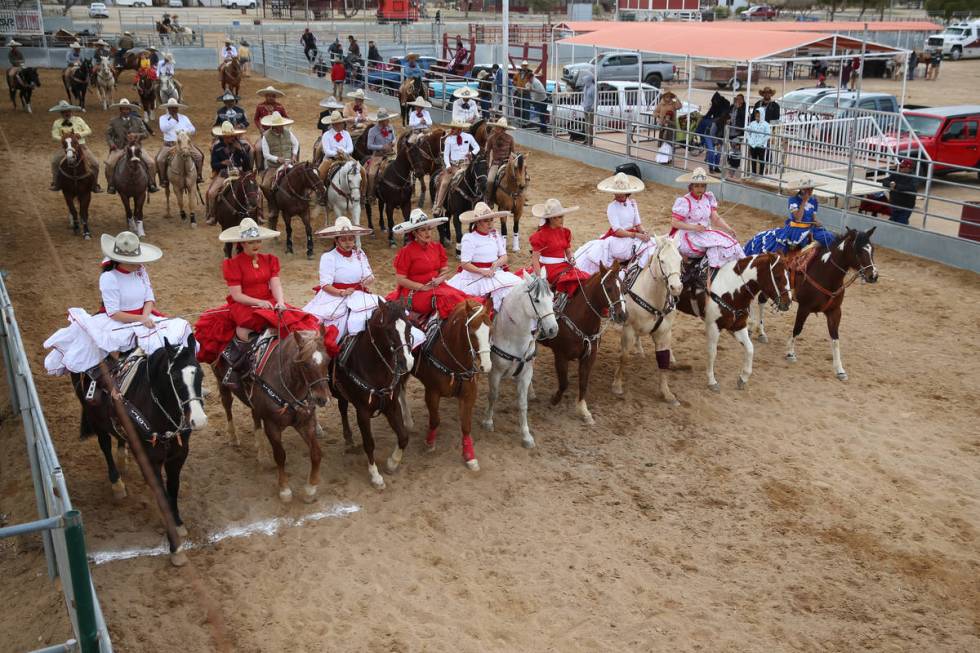
Now, she saw her chance to perform, to become part of an historic tradition prized by her culture. She wanted to try these exotic escaramuza routines herself.
“I remember telling my sisters, ‘That looks so pretty; let’s do it. We all have horses. How hard could it be?’ Well, little did we know.”
The year was 2013 and Colon, now 26, joined one of the Las Vegas Valley’s few escaramuza teams. Seven years later, she leads a competitive drill squad that puts in long hours of practice, the women gently encouraging their horses, repeating their self-designed routines — all with an eye toward earning the right to compete at the national escaramuza contests in Mexico.
And they’re cheered on toward success by an unlikely sponsor.
‘Tears came to my eyes’
At 75, Marilyn Gubler spent a career empowering women. In the early ’80s, she chaired Nevada’s Republican party, then became a political consultant, a role model for ambitious women of both parties.
Several years ago, Gubler bought a 160-acre spread in the Sandy Valley, 45 minutes south of Las Vegas, where she created a working dude ranch and corporate retreat. Along the way, the woman known as “Boss Lady” discovered the subculture of Mexican rodeo which is considered Mexico’s national sport.
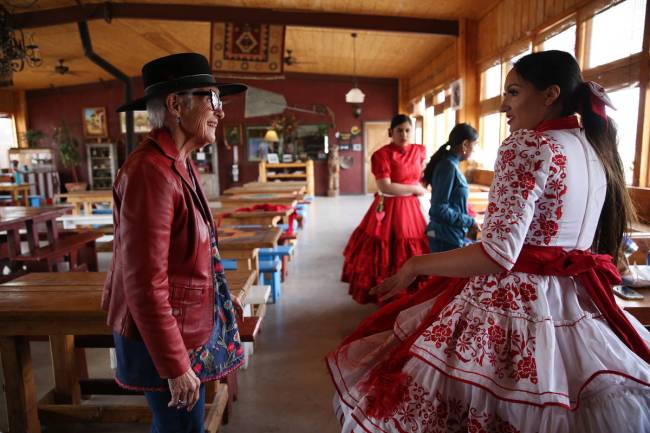
She and husband Tommy DiGiacomo built a traditional lienzo charro for local riders to practice and compete. Shaped like an exclamation point, with a rectangular area that connects to a circular arena, the space hosts rodeo events year-round.
Gubler first heard about escaramuza when the daughter of one of her ranch hands approached her about starting a team. Her research revealed the history behind the riding drills, whose name translates to “skirmish.”
During the Mexican revolution, female adelitas, or women soldiers, often fought alongside the men against the Spanish, riding into battle dressed in flowing gowns, their galloping horses creating clouds of dust designed to confuse the enemy.
Gubler quickly fell in love with these young queens of the Mexican rodeo. She marveled at the gorgeous costumes, pageantry and dedication. She loved how the family events helped preserve a rural Latino culture often lost in today’s urban life.
“When I saw the women perform, tears came to my eyes,” she said. “I do not want this sport to die. It’s too important to local Mexican culture.”
Gubler built a separate practice arena for the escaramuza riders, but that’s not all. She bought the team its first performance dresses and sombreros and has covered expenses for out-of-town competitions, mostly in California, home to 50 teams.
Each year, statewide contests are held across the U.S. to decide which teams will qualify to compete in the Mexican national events held each November, where the top team is awarded a trophy and $15,000.
Nevada’s five teams, based in Clark and Nye counties, were due to square off in Pahrump in early April, but the event was rescheduled for September due to the coronavirus pandemic.
Colon’s escaramuza team, named Altaira, an Arabic word for a high-flying bird, has enjoyed success both in the U.S. and Mexico. They’ve won every state competition held since 2013, and in 2017, placed 67th out of 200 teams that competed in Mexico.

For Colon’s riders, the season starts in January, when the women begin practicing in earnest, hosting fundraisers and raffling off bottles of tequila to collect money to pay for their coach, gowns and equipment.
Recruiting members remains a challenge. Riders, who range in ages from 14 to 26, must commit to a year with the group, own their own horse and be available to practice at least once a week. Often it means juggling jobs and schoolwork. Colon works in the corporate office of a dental firm. Others are casino workers, students studying accounting and nursing.
Each rider has her own reasons for devoting so much time to the sport.
Vanessa Juaregui, 24, revels in competing in a sport denied to her mother, Isela. Her grandfather, Jesus, was too conservative to allow his daughters to compete in a rodeo arena he defined as a man’s realm. “In his eyes, only men rode horses,” she said, “not women.”
In the years before his death, Juaregui’s grandfather eventually relented, allowing her aunt — her mother’s younger sister — to ride. Now, each time she enters the rodeo arena atop her horse, Juaregui thinks of Jesus. “He’s there riding next to me,” she said. “He helped instill in me this passion for horses.”
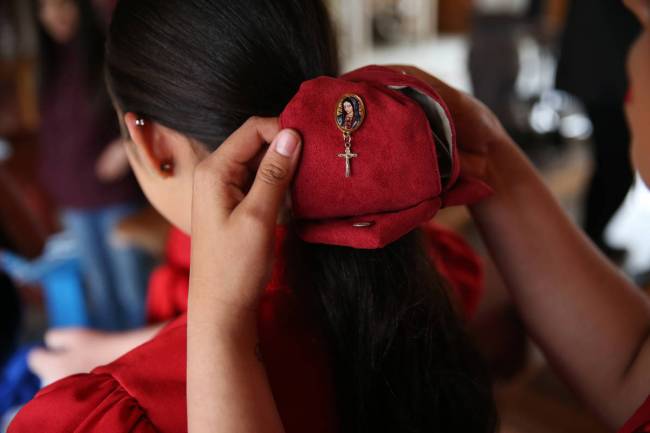
Her parents also have rallied around her. Her mother is there at competitions along with her father, who suffers from a physical disability. “If there’s a wheelchair available, he’s there, along with my Mom, rooting me on,” said Juaregui.
The practices require discipline. Each season means a new routine to choreograph. The women meet when they can. On weekends, they might practice for three hours in the morning before taking a lunch break to let the horses rest and enjoy a light barbecue prepared by their parents. Then it’s back to practice for another few hours.
Often the girls carp at one other when someone stumbles out of line, but they make it work. “They’re feisty,” Gubler said.
In the first years, she said, she battled an attitude problem among some younger members, who became jealous of opposing riders and each other. “They were falling into a trap, torpedoing and bad-mouthing each other,” she said.
At one point, Gubler suggested that she would withdraw her support if the situation didn’t improve. Nowadays, the women are more relaxed and even socialize with opponents, who ride on teams with names such as Amazonas, Prestigo and Colibris.
On a recent Sunday, the escaramuza women prepared to perform in an afternoon rodeo event. They were nervous, knowing they would be practicing new sequences while the men watched, for a moment giving up their coveted rodeo stage, resting their boots on the wooden corral fences.
That morning, inside a ranch dining hall, the women donned their red and white dresses, brushing one another’s hair, laughing the way teenage girls do.
“Is this mine?” one girl said, rifling through a handbag for a red hair bow.
“No,” another said. “But you can use it.”
The women know their gowns are nearly as important to their success as riding skills. In competitions, the team’s uniforms must match perfectly and judges deduct points and teams can even be disqualified for the slightest variance or imperfection.
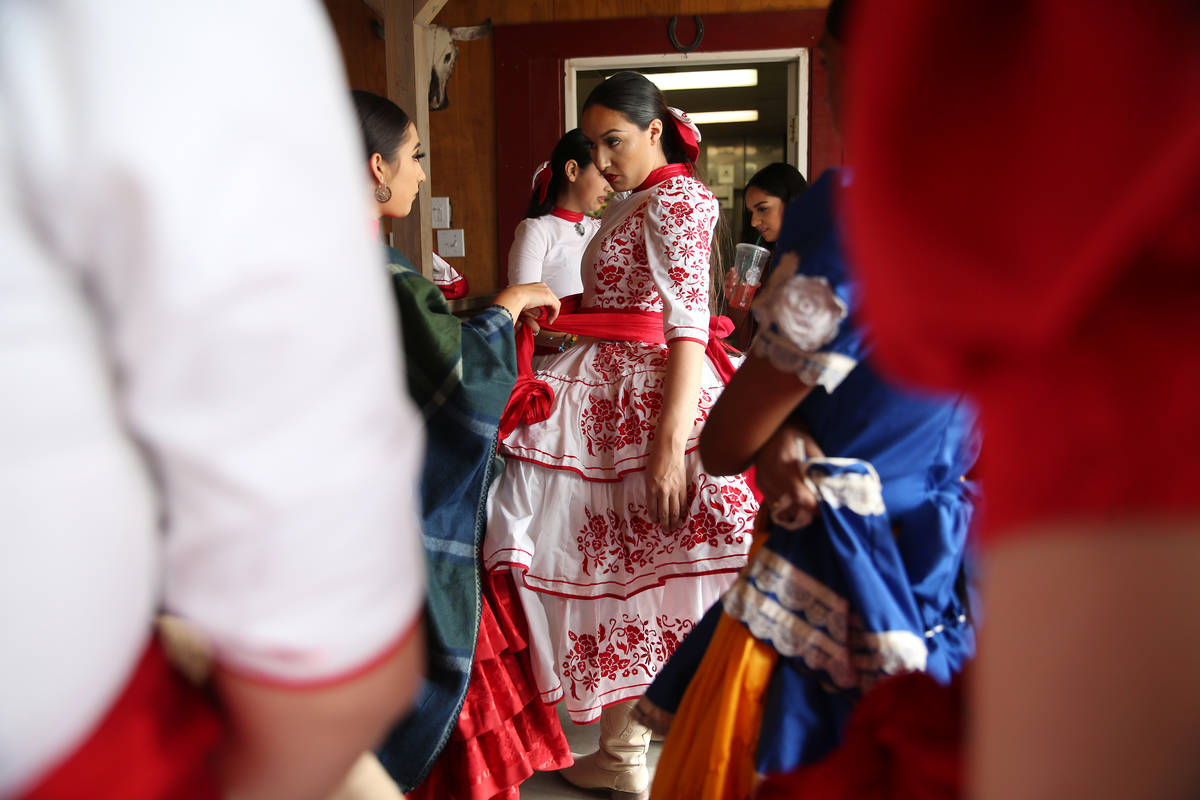
The dresses worn by the Altaira team are made by a Tijuana seamstress, who is revered for making gowns with form-fitting flair — mixing function, historical accuracy and femininity. To mimic those worn by the original aldelita, the gowns for Colon’s team feature designs on the torso that resemble the ammunition belts worn by the women soldiers of old.
Considering the expensive lace and the various layers of fabric required by judges, each garment can cost up to $500. Most riders buy two new dresses a season. With accessories such as sombreros, boots, horse care and coaching fees, expenses run into the thousands of dollars a year.
New dresses are coveted, used ones frowned upon. “You know women don’t like hand-me-downs,” Colon said. “Your dress is your showcase. You’re representing the female soldier ready to go to war. Your gown has to fit you perfectly. It must be flattering. You must wear it well.”
At age 16, escaramuza rider Linsy Enriquez says her gown bestows an aura of glamour. “I feel like I’m wearing tradition, representing something that comes from my cultural roots,” she said. “I feel really beautiful.”
In many ways, each performance is like going to the prom. “There’s competition among girls to see who shines most in their dress,” she said. “You can put on a dress and call it a day, but if you know the right way, you stand out from those who don’t.”
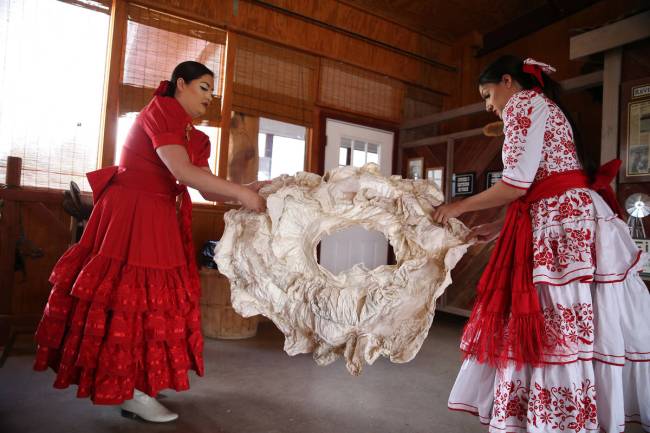
As the escaramuza riders readied themselves, younger girls, too young to compete, hovered at the edges. They watched intently, knowing in future years their turn will come.
One performer stepped into a “crinolina.” The fabric piece is boiled in corn starch to give it the consistency of paper mache, providing a bouncy lift beneath the flowing skirts. One girl joked the garment looks like a corn tortilla fresh off the grill.
The wide-brimmed sombreros are more helmet than hat, often made of rabbit but adorned with art designs. In Mexican ranch culture, the wide sombreros protect cowboys from the harsh sun.
The last bit of apparel were the riding boots. Most of these women far prefer wearing spurs to high heels. Finally, the team walked outside to ready their horses.
“Let’s rock and roll,” Colon said.
That’s when her father, Osbaldo Colon, rode up, looking majestic on horseback, like a figure from a romance novel. A lifelong horse lover, he provides horse-shodding services at the ranch. But on this day, he’s just a proud parent. He helped both of his daughters, Viri and 23-year-old Alondra, brush down and saddle up their rides. He has become a surrogate father to the entire team, watching after both the women and the horses. In seven years, he has yet to miss an event, or even a practice.
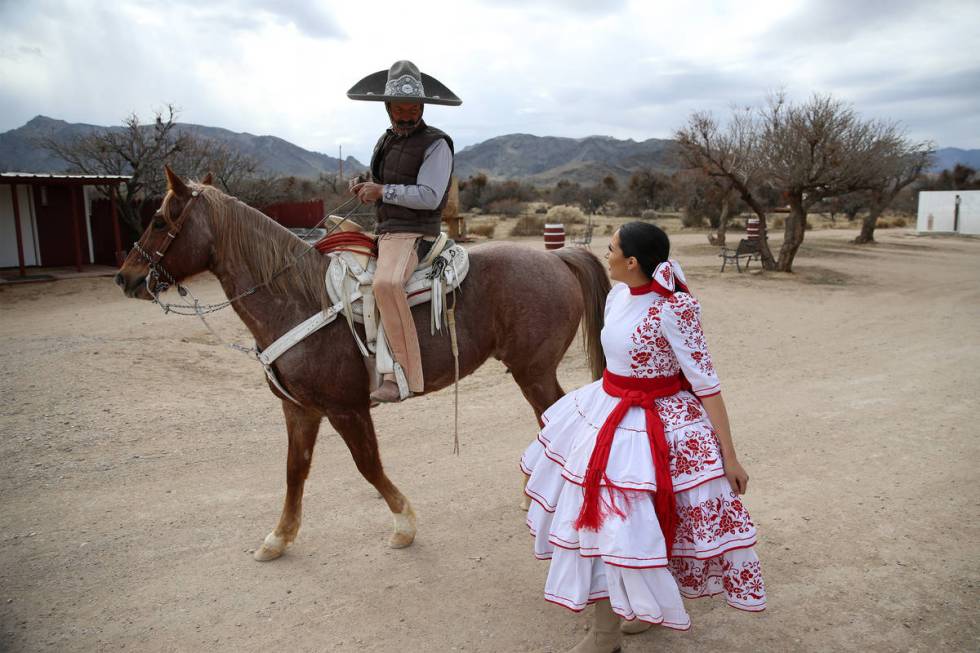
In the background were the sounds of a working ranch. Horses whinnied amid the thundering gallop of hooves. Rodeo fans have backed up their pickups to the arena, sitting on chairs arranged on their truck beds like tailgaters at a football game.
A woman peddled Mexican wheat flour duritos smothered in hot sauce. The escaramuza riders also sold corn-on-the-cob to help raise money. Children hung on the stable fences, pointing to baby goats, pigs, colts and ranch dogs.
Osbaldo stood between his two daughters, both mounted on their horses. Viri rode a red roan named Canelo, or cinnamon. Alondra rode a quarter horse named Bandolero.
“I have always had a passion for horses,” he said in Spanish. “And now my daughters do, too. That makes me proud.”
Moments later, the eight Altaira team members led a procession of rodeo riders into the arena. They formed a vertical line, the horses moving in slow, perfect step. A cowboy took a picture, a bottle of Modelo beer in his hand.
The rodeo performers, both men and women, paused and dipped their heads as the announcer recited a cowboy prayer. Then the rodeo was on. As the men performed, the escaramuza awaited their turn.
It’s addicting to be able to handle a horse that strong. The animal can think for itself, and yet he follows your commands.. ... It’s amazing.
Alondra Colon
To calm their nerves, they described the goal of the day.
“We must embody beauty, grace and strength,” Viri Colon said. “You have to ride with elegance. It’s a challenge to ride side-saddle, but you must do everything with grace.”
Added Alondra: “People see our routines and say ‘Oh, it’s beautiful!’ But it takes so much work to achieve that beauty.”
Alondra Colon has two small sons and her husband babysits when she practices and performs, playing a support role while his wife follows her passion.
“It’s addicting,” she said. “To be able to handle a horse that strong. The animal can think for itself, and yet he follows your commands.”
She paused. “It’s amazing.”
Enriquez said the women are sometimes as hard to choreograph as the horses. “You have eight girls with different attitudes piecing together a seamless routine,” she said. “To make it flow is just so difficult, but we make it happen.”
An hour later, the women reentered the circular arena, their right hands held aloft, hoping that the many hours of practice have paid off.
Even though this display is not an official competition, the women are perfectionists.
They pretended the judges were there. They had eight minutes, timed to the second, to enter and leave the area. That left five minutes for a routine that consists of 12 movements. This brief time on the rodeo’s center stage left little room for error.
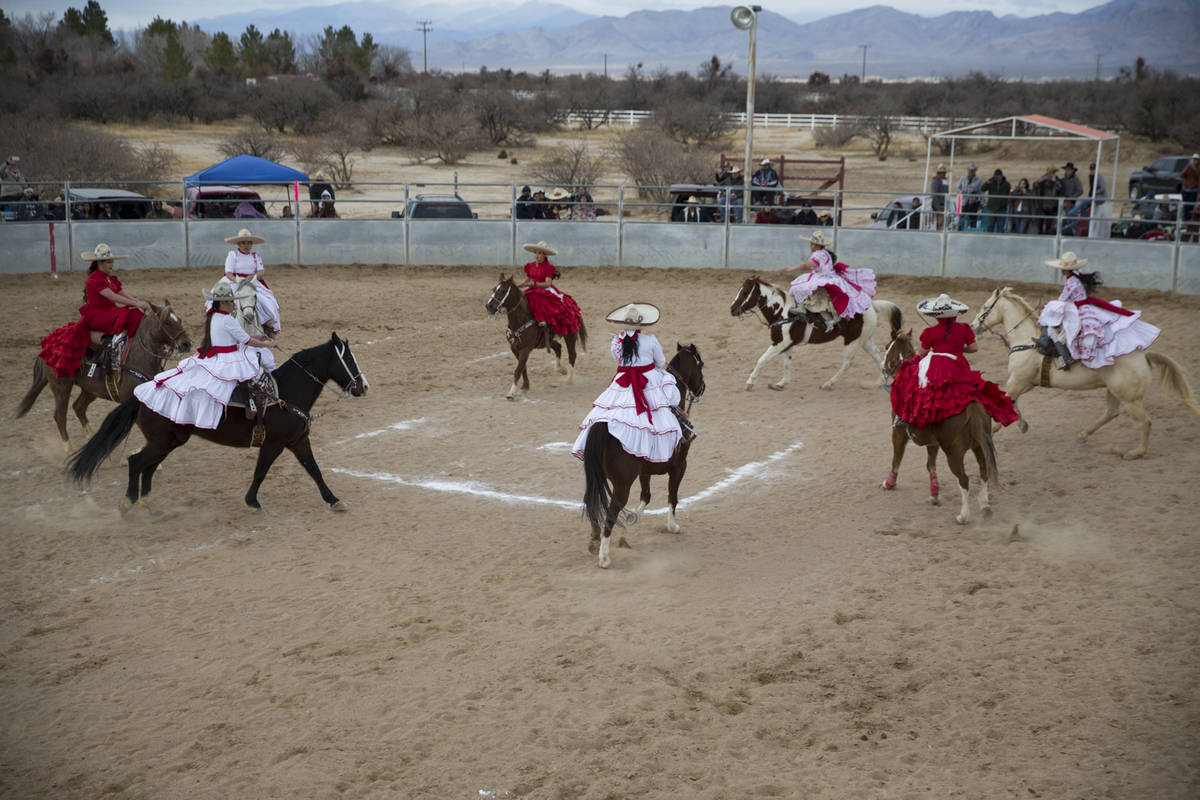
Before each competitive performance, teams submit to the judges a detailed sketch of their planned routine, which is then videotaped in progress. In state competitions, there are two judges, but in Mexico, there are five. That means many sets of eyes looking for the slightest defect, Colon said.
The rules allow for teams to challenge judges’ calls. Once, in Mexico, Colon questioned a verdict that two of the team’s horses had collided during the routine. Colon consulted the tape and won her argument, saving Altaira 42 points.
She felt like a lawyer who had prevailed before some high court. “I thought to myself, ‘Oh my gosh, the process works! I used the rulebook to my advantage.’ ”
On this Sunday, the routine involved riders and horses moving around a large square marked in the dirt. The team kept moving, working through choreographed maneuvers. They veered off in groups of two and three, circling the edges of the arena and moving back to the center, crossing one another precariously close, the horses sometimes pausing to perform small pirouettes.
“Va!” Viri Colon commanded at points, “Go!” urging the riders to respond on cue.
The program resembled a balletic rendition of soldiers in battle, horses of different sizes and gaits all moving as one, the women straight-backed, determined, elegant.
When it was done, the escaramuza riders were pleased with their new routine. As they left the arena, Gubler was waiting.
So was Osbaldo Colon. “My Dad never says a bad thing,” Alondra said. “He’s biased. He always says ‘You guys did really good.’ ”
He knows that for those few shining moments, this team, these women, his daughters, have commanded the rapt attention of a male dominated world.
With grace, beauty and power.









